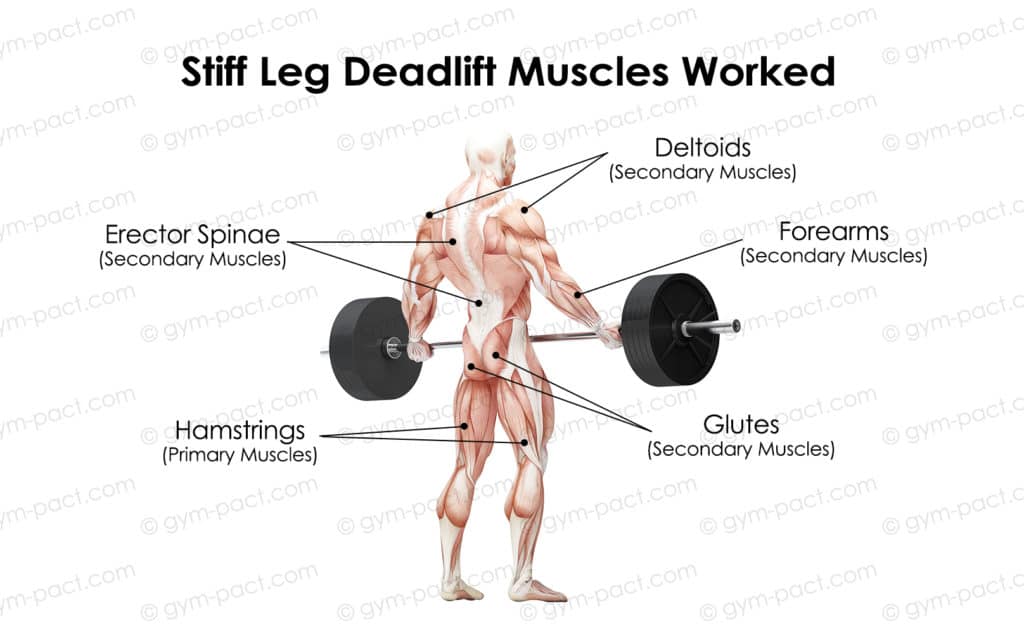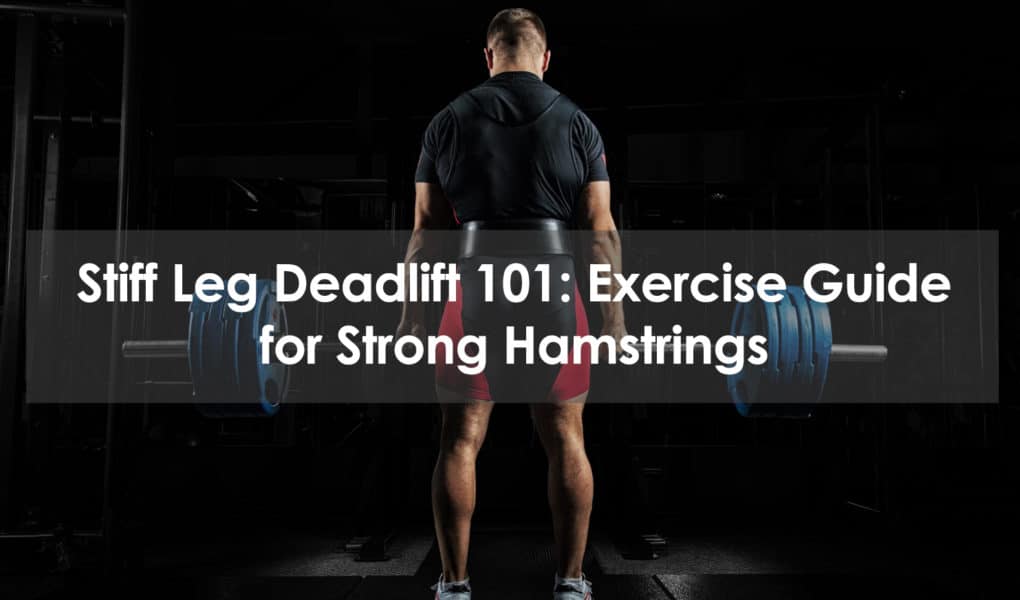The standard American deadlift is known as a foundational compound exercise to work your latissimus dorsi muscles of the mid back as well as the erector spinae. There are, however, a number of variations to this exercise that transfer the focus of the exercise to different parts of the body. One of them is the stiff leg deadlift. This version of the movement will shift the focus to your hamstrings.
Benefits of Stiff Leg Deadlift
1. Hamstring Focus
The stiff leg deadlift allows you to directly work the hamstrings through their full range of motion with a significant amount of weight.
2. Home Gym Friendly
Most hamstring exercises require expensive weight machines, which makes the stiff leg deadlift a very useful exercise if you are working out in a home gym.
3. Injury Prevention
The hamstrings are probably the most neglected muscle group in the body. That’s why so many people suffer from a pulled hamstring. Doing an exercise such as the stiff-legged deadlift will allow you to strengthen and develop your hamstrings.
Muscles Worked

The main muscle worked by this movement is the hamstrings. This is a group of four muscles that are located on the back of the upper leg. Those four muscles are the biceps femoris long head, the biceps femoris short head, the semimembranosus, and the semitendinosus.
All four parts of the hamstrings work together to form the function of knee flexion, bending the knee to bring the heel back and up toward the butt. A secondary function of the hamstrings is assisting the glutes in hip flexion.
Secondary muscles worked in this exercise are the glutes, the erector spinae muscles of the back, the deltoids, and the forearms.
How to Perform Stiff Leg Deadlifts
- Stand with a loaded barbell held at arm’s length with an overhand grip. Keep your feet shoulder width apart.
- Hinge your hips back and, with your legs straight, lower the bar down your legs until it reaches your mid-shin level.
- Reverse the movement to return to a standing position.
Tips
Squeeze your glutes forcefully in the top position. Do not bend your knees as you do this exercise. This is primarily an isolation exercise for the hamstrings so you do want to go too heavy. Focus on performing the exercise correctly and moving through a full range of motion. The action should happen at the hip joint. Keep the bar close to your body rather than letting it move away from your body.
Maintain a neutral spine position throughout the entire movement. This will prevent your torso from rounding.
Common Mistakes to Avoid
1. Rounded Knees
The most common mistake on this exercise, as well as the standard deadlift, is rounding off the back. Focus on maintaining a neutral spine position with no arching throughout the entire range of motion.
2. Bar Drift
Many people have a tendency to allow to bar to move away from their bodies. This contributes to back rounding. Be sure to keep the legs straight (no knee bend) and the bar close to your body.
3. False Grip
Another common mistake is to use a false grip where the thumbs are under rather than wrapping over the bar. In this grip position, it is more likely that the bar can slip out of your hands. Always use an overhand grip where your thumbs are wrapped over the bar.
4. Pulling with Arms
A final mistake that people make when doing this exercise is that they pull with their arms when coming out of the bottom position. This transfers the focus to the biceps, triceps, and deltoids. That is not what you want. Remember that your arms are merely hooks in this exercise; the work should be done by your hamstrings.
Stiff Legged Deadlift Variations
1. Stiff Legged Deadlift with Dumbbells
- Stand with a pair of dumbbells held at your sides, and your feet hip-distance apart. Your thumbs should be facing forward in a neutral grip.
- Without bending your knees, lower the weights down your legs until they reach your mid-shin level. At this point, you will feel the stretch in your hamstrings.
- Reverse the motion to return to the starting position.
2. Kettlebell Deadlift
- Hold a kettlebell with both hands in front of your body at hip level.
- Without bending your knees, lower the bar down to the middle of your shins.
- Reverse and repeat.
3. Cable Stiff Leg Deadlift
- Load the pulley on a cable machine to the level of your ankles.
- Grab the handles and stand facing the machine, about three feet in front of it.
- Position yourself so that in a fully erect position the weights are about 12 inches off the stack.
- Without bending your knees, hinge the hips to bring the cables down to your mid-lower leg level.
- Buck the hips forward to return to the start position, squeezing your glutes and hamstrings in the process.
The Bottom Line
The stiff-legged deadlift is a conventional deadlift variation that allows you to turn the exercise into a lower body-centric movement. It will place the emphasis on your hamstrings to help you develop strength and muscle mass in this often neglected body part.
Related Post: 11 Best Romanian Deadlift Alternatives
I suggest performing 5-6 sets of straight leg deadlifts, with pyramided rep ranges in which you start with 20 reps with light weights, then drop 15 reps as you increase the weight slightly. Set three should drop to 12 reps with another weight increase. For your final 2 or 3 sets, use your heaviest weight for 8-10 reps.
Frequently Asked Questions
Are stiff leg deadlifts for back or legs?
The stiff leg deadlift is primarily a hamstring exercise. Although the erector spine muscle of the lower back is worked secondarily, it is not the main focus of the exercise. Other lower body muscles worked in this movement are the glutes and calves, so this is definitely a leg rather than a back exercise.
Is Romanian deadlift the same as stiff leg deadlift?
No, the Romanian deadlift is not the same as the stiff-legged deadlift. The two movements look very similar as they both start in the same position, with the bar at about the level of your calves. The big difference is the amount of knee bend, With the stiff leg version, you have a slight knee bend, whereas the stiff leg version has no knee bend whatsoever. The bent knees on the Romanian version allow for a greater degree of the hip hinge.
Related Post: Romanian Deadlift vs Deadlift: Which Version is Better?
When you are doing the stiff leg version of this exercise, you take the bar down lower than in the Romanian version between each rep with it going down to shin level.
Is stiff leg deadlift harder?
The stiff-legged deadlift is harder in that you cannot use as much weight as you could on the regular deadlift. That is because it is targeting a smaller muscle group (the hamstrings) than the traditional barbell deadlift (the lats). You should use a lighter weight and focus on proper form.







